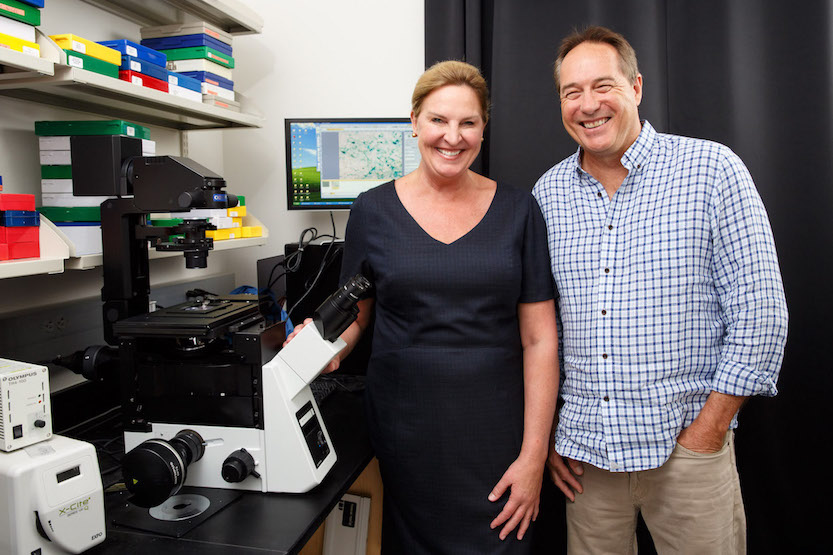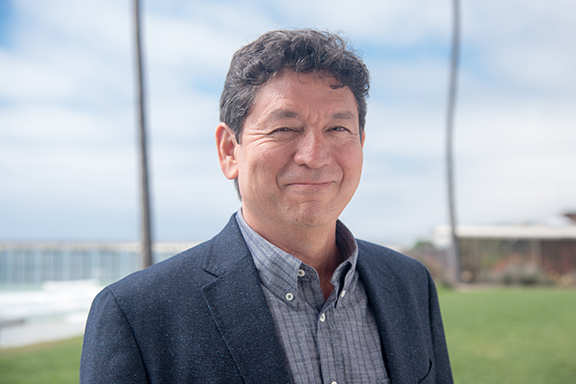Daily Business Report-Sept. 8, 2017
Mark Merrifield is an internationally recognized researcher in the areas of sea-level rise and climate variability, coastal oceanography, and nearshore processes.
World Renowned Scientist to Direct
New Climate Research Center in San Diego
Mark Merrifield, who has spent the past two decades studying global and regional sea-level change, will lead a new research center at Scripps Institution of Oceanography tasked with understanding impacts of projected changes in climate.
A Scripps alumnus, Merrifield returns to campus from a 20-year stint as director of the University of Hawaii Sea Level Center. He will serve as director of the Center for Climate Change Impacts and Adaptation, which was created in 2015 with a $5 million gift from longtime Scripps supporters Richard and Carol Hertzberg.
The goal of the center is to draw on the expertise of climate scientists like Merrifield as well as experts ranging from economists, sociologists, and engineers to urban planners and political scientists to document climate change impacts on the environment, ecosystems, and humans and to devise practical solutions to climate change effects widely regarded as inevitable. Besides sea-level rise, those effects range from coastal erosion and flooding to the spread of human health impacts and the increased incidence of drought and extreme weather events.
Scripps Director Margaret Leinen said that while the center will have a strong focus on the San Diego region and state issues, it will operate nationally and globally as well because solutions it develops will be exportable.
Merrifield is an internationally recognized researcher in the areas of sea-level rise and climate variability, coastal oceanography, and nearshore processes. He received his PhD in Oceanography from Scripps in 1989, was a postdoctoral researcher at the University of New South Wales in Sydney, Australia from 1989 to 1991, followed by a return to Scripps as a project scientist and researcher. In 1994, he joined the faculty at the University of Hawaii at Manoa in the Ocean Engineering department, subsequently moving to the Oceanography department from 1997-2017. He has a longstanding interest in linking basic and applied research outcomes to practical solutions for societal benefit.
___________________
Port’s Harbor Police Chief to Helm
Nebraska’s Top Law Enforcement Agency

John Bolduc, harbor police chief for the Port of San Diego, has been named head of the Nebraska State Patrol, the state’s top law enforcement agency.
Bolduc, 52, will start his new job on Oct.16. His annual salary will be $150,000. His selection was annunced by Nebraska Gov. Pete Ricketts.
As vice president of public safety and police chief at the port, Bolduc oversees 170 employees and an annual budget of $38 million. Since joining the port in 2010, Bolduc has focused on shaping the Harbor Police Department into a 21st century law enforcement agency. He is credited with transforming the Harbor Police Department to an intelligence-led policing model, a combination of technology and people working in concert to address crime and quality-of-life issues.
Bolduc previously served as chief of police for Brainerd and Mora in Minnesota. He began his career in law enforcement as a police officer in 1986. During his time in Minnesota, he served on and chaired the Minnesota Board of Peace Officer Standards and Training.
Bolduc holds a Master of Science in Organizational Leadership from National University and a Bachelor of Science in Criminal Justice from Bemidji State University. He is also a graduate of the Federal Bureau of Investigations (FBI) National Academy.
“While this opportunity represents an honor and career milestone for Chief John Bolduc, the Port is losing a dedicated leader who is respected and admired by people throughout the organization,” said Port CEO Rand Coniglio.
___________________
City Receives $3 Million Grant
to Upgrade Composting Facility
The city of San Diego’s Environmental Services Department has been awarded a $3 million grant from the California’s Department of Resources Recycling and Recovery to upgrade its current composting facility, the Miramar Greenery, and fund a food rescue program.Through a public/private partnership with Kitchens for Good, unused produce and food from grocery stores that would otherwise end up in the landfill, is made into free, nutritious meals that are delivered to seniors and low-income residents. Aspiring cooks and chefs working for Kitchens for Good will benefit from culinary industry job training and education.
This program, along with upgrades to the composting facility, align with the city’s Zero Waste Plan approved by the San Diego City Council in June 2015. The Zero Waste initiative is also a critical component of the city’s innovative Climate Action Plan, which won council approval in December 2015.
___________________
San Diego County Home Sales
Steady at End of Summer
August sales of previously owned homes in San Diego County closely mirrored sales in July, according to housing statistics compiled from the Multiple Listing Service by the Greater San Diego Association of Realtors.
Approximately 3,248 single-family homes and attached properties closed in August, compared to 3,228 in July, a difference of less than a percent.
Broken down by property type, single-family home sales were up 2 percent, while condominium and townhome sales were down just under 3 percent. However, compared to August of last year, single-family home sales were down 6 percent and condos/townhomes were down 11 percent.
The median price in August dipped, but only slightly, compared to July. The price of both single-family and attached properties were down by about a percent. Despite that, prices for resale properties are up more than 8 percent so far this year.
“Home sales tend to cool off ahead of a new school year,” said SDAR President Bob Kevane. “but in this market deals can be made well into the school months. I’m hopeful that mortgage rates, wage growth, and unemployment will stay stable and buoy up our struggling housing market.”
In August, the ZIP codes in San Diego County with the most single-family home sales were:
92026 (Escondido North) with 69
92057 (Oceanside North) with 69
92128 (Rancho Bernardo West) with 54
92065 (Ramona) with 53
92028 (Fallbrook) with 51
The most expensive residential property sold in San Diego County last month was a remodeled beach cottage on the bluffs in Del Mar – 2,300 square feet, 2 bedrooms, 3 baths – built in 1948, with a sale price of $10 million.
Click here for a detailed look at the numbers.
___________________
San Diego Employers Association Offers
Management Essentials Certificate Program
The San Diego Employers Association offers the Management Essentials Certificate Program starting on Sept. 12 and running every Tuesday for nine weeks from 9 a.m. until noon. The program is designed to expand the skills and knowledge of new or recently promoted managers and supervisors.
Topics covered include communication, managing conflict, conducting interviews, conducting performance appraisals, documentation and discipline, and employment law, among others.
The nine-week program costs $999 for SDEA members and $1,499 for non-members. Participants who successfully complete the program receive a Management Essentials Certificate at the end of the program.To learn more and to register, visit www.sdeahr.org.
___________________

Scientists Identify Compounds
That Significantly Increase Healthy Aging
Aging happens to everyone, but it may no longer mean a descent into disease or chronic disability. Recently, scientists from the Florida campus of The Scripps Research Institute (TSRI) identified a class of compounds, using animal models and human cells, that significantly delays the onset of several age-related symptoms and extends healthy aging — what has come to be known as “healthspan.”
The study, published in the journal Nature Communications, was led by TSRI Professor Paul Robbins and Associate Professor Laura Niedernhofer.
This newly identified class of drugs targets senescent cells — cells that have stopped replicating because of chromosome damage. As we get older, senescent cells accumulate, becoming a major contributor to age-related diseases.
Robbins and his colleagues developed a new screening platform to look for drugs that specifically affect senescent cells. They identified a class of compounds that inhibits a stabilizing protein as having significant anti-senescent activity.


